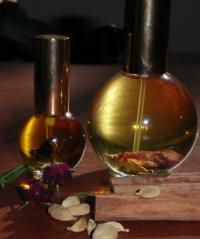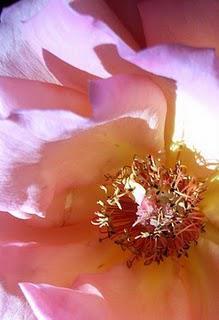 The Mystery of Musk project has given me much food for thought...especially about the challenges we face designing with naturals.
The Mystery of Musk project has given me much food for thought...especially about the challenges we face designing with naturals.So I thought I'd share a few of them with you....
Botanical or Natural Perfumery is very different from conventional perfumery.
There is the more obvious point that we use natural ingredients as opposed to the artificial chemicals used in modern perfumer laboratories of course. And this tends to lend a depth and beauty to natural perfumes that simply can't ever be fully recreated by artificial ingredients....
But it also has a number of unique challenges that many newcomers to the art don't realize are there at first. Keep in mind that these are my own observations from over 20 years of fiddling with natural scent ingredients...and they are my own opinions, which may differ greatly from what you will read in some of the books out there. There are many different approaches, and different things work for different people. Hopefully this will inspire some more discussion on the various perfumeing lists!
Complexity:
One of the biggest ones is that each ingredient used in botanical perfumery, is actually already a complete scent all in itself.
Each essential oil or absolute, is an extract of an incredibly complex botanical scent creation, custom designed by Ma Nature to entice and delight the senses of an incredible array of insects and mammals.
Modern perfume chemistry started by attempting to copy Mother Natures ingenious complexity, primarily for money reasons. It is far cheaper to create an artificial copy made with individual chemical components, than to obtain say rose otto by the time honoured process of growing the flowers, harvesting them, useing the time and tons of flower petal consuming process of enfleurage to then obtain only a few kilos of the precious substance....
But the chemical version is never as good. Ma Natures masterpiece is simply to complex and clever to be fully re-created.
But the challenge in natural perfumery comes from this very complexity.
In the over 20 years I've been playing with natural perfumes, I've mixed so many blends that looked lovely on paper...but that turned out to be muddy, unpleasant or even downright nasty messes once I'd actually combined the ingredients! And there's very good reasons for this:
 When you start to blend say rose otto and jasmine absolute, you are combining not one or two scent molecules, but what amounts to two incredibly complex and complete perfumes!
When you start to blend say rose otto and jasmine absolute, you are combining not one or two scent molecules, but what amounts to two incredibly complex and complete perfumes!Think about this for a minute......
Each time you add another natural ingredient to the mix, you add not one note, but a complete complex array of hundreds of scent layers, each with the potential to harmonise or clash with any of the other hundreds of scent layers already at play in the mix!
It's a bit like playing ultra-multi dimensional chess.
You have to understand and somehow keep in your mind, each of the many many scent layers each indivisual oil or extract is made up of, and see how they will combine and work with each other.
Add to that that once the ingredients are combined, they go through a further chemical combining process, and often change quite substantially as they interact with each other.
I've lost count of how many times I'd created something that smelled lovely...only to come back to it after a week or so to find that it had somehow morphed into something 'orrible!
The reverse can sometimes also be true of course, and sometimes you accidentaly create a beautiful scent that was not at all what you originally had in mind...But usually it's the lovely turning into crap that happens.
Top Middle and Base Note classification
This is one of the primary ways that scents are classified and designed nowadays. You will find mention of the concept in most perfume reviews and technical perfumery handbooks. and even the books on I have found on Natural perfumery contain lists that attempt to place all of the imany essential oils and absolutes we use in one of these three categories.
The problem with this (in my experience), is that it simply doesn't work.
As I said before, each and every ingredient we use in botanical perfumery, is in itself a complete perfume creation, with top base and middle notes all of it's own.
Some of course contain predominantly top notes, others more base notes, but this in itself is not enough information to be able to work with it. Realistically you need to understand and know the various top middle and base notes that each ingredients contains so you can marry them to the appropriate combination of top, middle and base notes that make up the other essential oils or absolutes you are useing.
Designing with Accords
This is another concept that is basic to conventional perfume design. The idea is to first create perfume notes or "accords", such as "Green grass", "Oriental" or "White Flowers" and then combine them to create a Smokey, Oriental perfume with a White Flower heart.
Sounds good eh? Trouble is, it often doesn't work. Once you have combined the three accords, you suddenly end up with either a muddy mess, or completely new sharp nasty notes sticking out at various layers which don't seem to have been present in the original individual accords!
There's two reasons for this:
Firstly with creating an accord. If you go back to what I wrote further up about complexity, you can see the difficulty this presents. Of course it's not impossible, but it can be a very involved and trial and error process.
And there are many "notes" that are close to impossible to create, simply becuase the individual ingredients are so complex that you cannot create anything "pure". For instance, I crave "Green Grass", which was a perfume oil favourite of mine as a teenager. You cannot buy "Grass" essential oil, and tincturing it doesn't seem to give you a real "grass" scent". And I have not been able to find a combination of other naturals that gets anywhere near the fresh cut grass scent I'm searching for. (At this point of course any number of other natural perfumers may chime in and tell me I'm wrong...I'm hoping they do! And that they will be nice enough to tell me how!!)
But it's a good example of the problem.
Realistically, you have to work with interesting notes, that do not fit clearly in any simple category because they are simply too complex to resemble any one clear note or accord. Your "White Flowers" may have many other subnotes to it that are neither white, nor very flowery...but still really pretty overall.
The second stage of the problem comes when you start to combine the accords you have created.
Taking the White Flowers accord idea, once you combine it with another accord, you may well find that the woody acrid note that was originally just barely perceptabley in the the background, has suddenly become a totally in your face blast of burnt plastic. This will have happened because it ganged up with another sweet plastic note from the oriental blend that you didnt even know was there! Or maybe the slightly decomposing background note in the Green Grass accord that just added that touch of "natural" when you created it!
Often it would be just one oil or absolute that was destroying the plan...but the sheer number and complexity of the ingredients would make it almost impossible to track down which one it was.
 I started out working with accords, but in the end I took a few steps back, and nowadays will usually add ingredients one by one, and take detailed notes on the effect they have on the overall mix. Which means I end up with a whole collection of trial blends of the various layers and stages of each perfume in tiny bottles!
I started out working with accords, but in the end I took a few steps back, and nowadays will usually add ingredients one by one, and take detailed notes on the effect they have on the overall mix. Which means I end up with a whole collection of trial blends of the various layers and stages of each perfume in tiny bottles!My latest creation for the Mystery of Musk project is a perfect example! It's various stages fill up a whole shelf all on their own, not to mention the myriad of tables, notes and scribblings I wrote in the process.
(If you're interested in hearing more about this, Monica Miller of Skye Botanicals will be writing more about the trials and errors in the botanical perfumeing adventure soon!)
Anyway, hope you enjoyed reading a bit about how I approach botanical perfumery....(And yes, I am writing a book on the subject...I'll be posting more bits and thoughts as it grows!)
Happy Sniffing!
